November 11, 2024
The American Political Items Collectors Convene Near Philadelphia
The show hosted by the Mid-Atlantic Chapter of the national organization showcased thousands of political and pop culture items dating back to the 1800s.
Key Takeaways
• Long-Standing Tradition: The APIC shows have been important for political memorabilia enthusiasts for over 60 years. Exhibitors and attendees share a love of history and the evolution of products like pins and posters.
• Diverse Collections: The events showcase a wide range of political and pop culture memorabilia, from rare presidential campaign buttons to promotional products.
• Generational Interest: The APIC events attract both seasoned collectors and younger enthusiasts, who have specific historical interests.
Susan Fratkin wouldn’t miss the American Political Items Collectors (APIC) event near Philadelphia. She and her husband, Robert, have been exhibiting for the past 30 years.
“I didn’t collect before I met my husband,” says Fratkin. “But when we were dating, he took me to one of these events, and now here I am.”
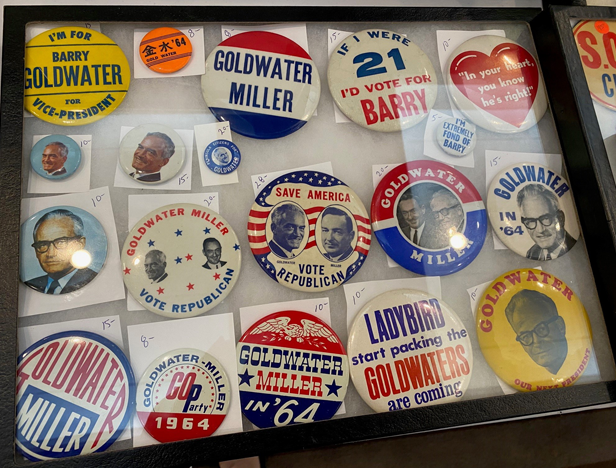
Robert and Susan Fratkin have a vast collection of political memorabilia – including buttons from Barry Goldwater’s 1964 presidential campaign.
The Fratkins, who live near Washington, D.C., and have one of the largest political memorabilia collections in the country, were among the 100 exhibitors at the APIC Mid-Atlantic Chapter’s regional show on Nov. 8 and 9, held in Langhorne, PA, outside Philadelphia. Open to the public, history-loving exhibitors and attendees can buy, sell and trade in just about any type of mementos imaginable – from presidential campaign buttons dating from the late 1800s to convention ribbons and hats, to pop culture pins and posters.
Collectors often bring big-ticket wares to APIC’s annual National Convention, held this year in Washington, D.C. “You’ll see items dating back to George Washington, like metal coat buttons with his initials,” says Fratkin. “People have china sets from different White Houses, statues, signs and flags from way back.”
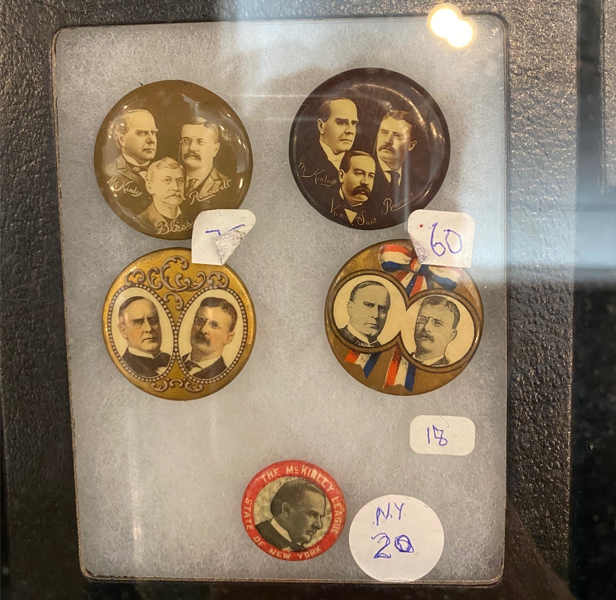
These buttons (“jugates” depict two people and “trigates” depict three) date back to the McKinley campaign in 1900, with Teddy Roosevelt as his running mate. Cornelius Bliss was chairman of the Republican State Committee for McKinley.
Her husband, Robert, says one of the most coveted pieces of presidential memorabilia is a rare button (called a “jugate” because it depicts two people) from the 1920 campaign depicting James M. Cox and his running mate, Franklin D. Roosevelt. It’s valued at almost $50,000.
APIC’s Mid-Atlantic Chapter has been meeting since 1970, first in New Jersey, and always the Friday and Saturday closest to Veterans Day. The ballroom offers an interesting survey of American political and cultural history.
The national organization was founded in 1960, and now has 20 geographical chapters across the country as well as 10 specialty chapters, with members who focus on specific campaigns, like those of Gerald Ford and Barack Obama.
“Everyone has their niche,” says Ted Hake, an exhibitor from York, PA, who recently wrote a book called Button Power, which traces the history of the branded pin from 1896 to 2020. “Some people only collect a specific candidate, like William Jennings Bryan.”
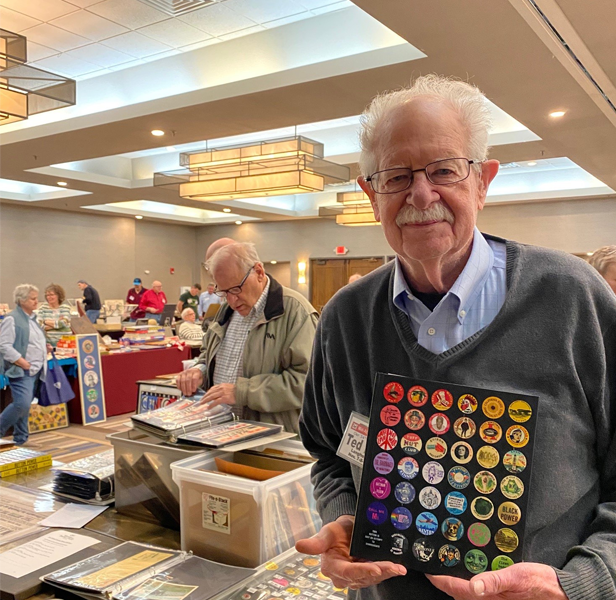
Ted Hake’s latest book is Button Power, which he co-wrote with fellow Chicago-based pin enthusiast Christen Carter. He’s been a member of APIC for 60 years.
Hake, founder of Hake’s Auctions, has been a member of APIC since 1964. He started collecting coins as a boy and then got interested in buttons as a film student at New York University. He never did go into filmmaking, instead choosing to make a living buying and selling memorabilia – mostly political and pop culture pins.
Hake’s collection includes thousands of buttons and posters from presidential campaigns, social causes, musical groups, promotions for everything from soda to seeds, and community events like fairs, produce expositions and political meetings. He’s also got one of the country’s largest LGBTQ button collections.
Tony Lee, president of APIC, has been a member since 1982. His table at the event featured buttons from presidential campaigns, pop culture and product promotions – like Ballantine Beer, Coca-Cola and Cap’n Crunch. At home, he has bobbleheads from the Kennedy and Nixon campaigns in the 1960s.
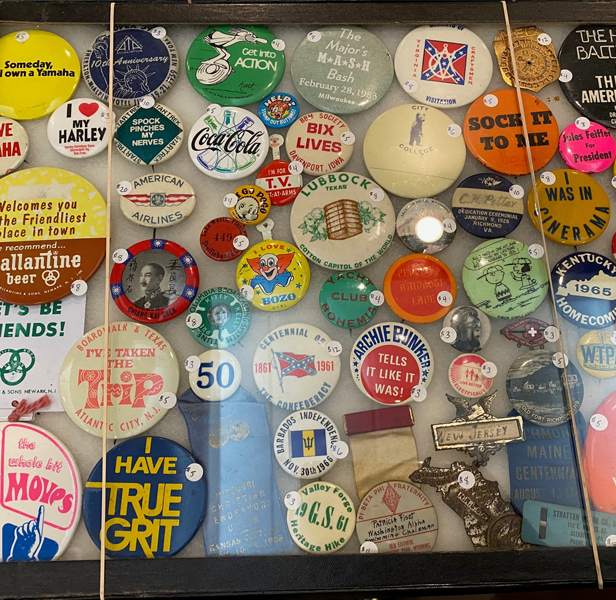
Buttons in Lee’s collection include items promoting consumer goods, like beverages, equipment and transportation.
“People collect from specific campaigns, maybe just Democrats or just Republicans,” he says. “There’s a lot of pop culture here too.”
Buttons were more “alive” back in the late 19th and 20th centuries, says Susan Fratkin – they used bright colors that could be seen from a distance, and put small details on each piece. In the 1800s, button manufacturers started putting ferrotypes on buttons – small photographs on metal. By William McKinley’s campaign in 1896, companies were putting plastic on top and crimping it around the back. In fact, the earliest known dated button is from the Indiana State Medical Society’s annual meeting in May 1896.
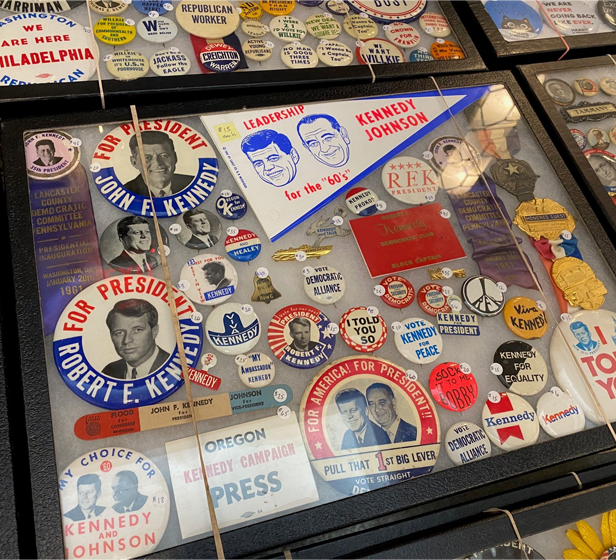
Lee’s collection includes presidential memorabilia from the early to mid-20th century.
By Woodrow Wilson’s campaign in 1912, manufacturers were making lithographs, transferring an image to paper with a plastic coating to protect it. Metal lapel tabs were big during World War II.
“They really did some creative things,” says Fratkin. “They did 3D peanuts on buttons for the Jimmy Carter campaign because he was a peanut farmer. The issues of the day were very visible. You can see the whole evolution of the button on these tables.”
Young collectors are beginning to attend APIC’s events and find their niche, says Hake. “We like coming here and seeing old friends,” he adds. “And exhibitors love when they see the younger attendees.”
ASI Research recently found that, in the most recent presidential election, candidate Kamala Harris vastly outspent President-Elect Donald Trump on print and promo collateral to the tune of nearly $5 million between July (when Joe Biden withdrew his re-election bid) and September. Trump by contrast spent a fraction of that – just $1 million.